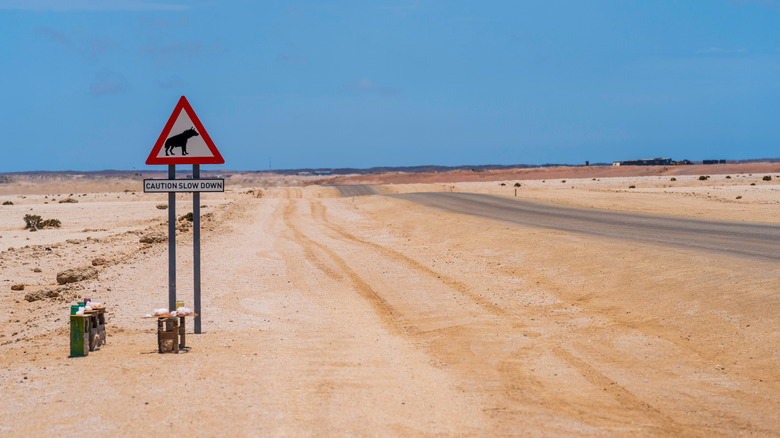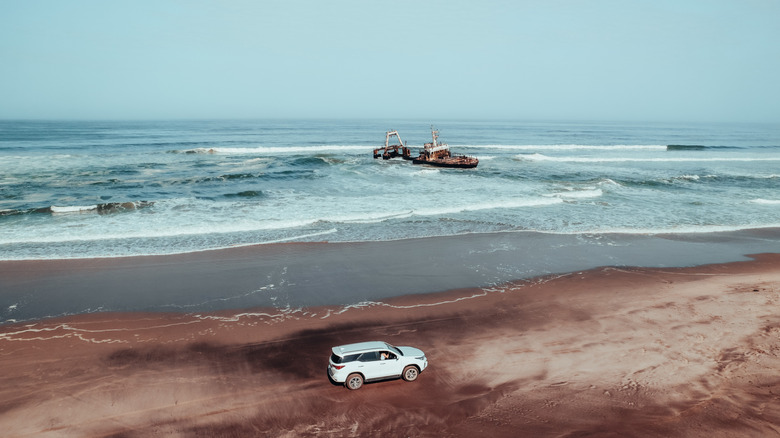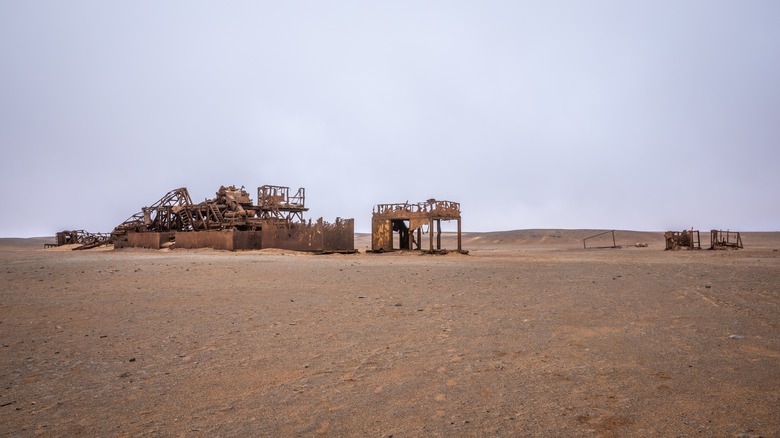The 'Skeleton Coast' Of This African Country Is One Desolate Yet Breathtaking Panorama
To the northwest of South Africa along the continent's Atlantic coast lies the republic of Namibia, a sprawling, ecologically-diverse nation with a population of just 2.8 million. There are many reasons to visit Namibia, but the main draw for many travelers is the wildlife, with the water-rich Etosha National Park in the north a popular destination for safari expeditions. But for those whose idea of a great vacation is to travel to one of the world's most desolate landscapes, the biggest must-see is Namibia's Skeleton Coast, a 310-mile-long national park that is also the world's most jaw-dropping cemetery, with great hunks of washed up metal, wrecked ships, and enormous whale bones protruding from the sand.
Driving the accessible parts of the Skeleton Coast by car can take around 8 hours without stops, and it represents one of the most solitary expeditions you could possibly take, in one of the world's harshest environments. Long stretches of the Skeleton Coast are nothing but sand and gravel roads with the choppy sea crashing on the shore beside you. But while such a trek is undoubtedly an undertaking and shouldn't be approached casually, it is also highly rewarding, with once-in-a-lifetime sights and a wealth of unexpected attractions — and wildlife including zebras, hyenas, oryx, giraffes, and even elephants and cheetahs — to encounter.
Traveling the Namibian Skeleton Coast
What do you need to know to take the trip of a lifetime through one of the world's most unforgettable landscapes? Luckily, despite its apparent wildness, the Skeleton Coast has been attracting curious travelers for years, and today it is possible for explorers to traverse it by car, staying at remote campsites along the way.
Many travelers like to experience the Skeleton Coast by self-driving: Hiring a pick-up truck or "bakkie" and hitting the road in whichever direction suits them best (if you choose to do this, make sure to get a car with working air conditioning), though you can also be driven by a guide. Most coming from South Africa into Namibia will travel north along the coast, meaning that their journey begins in Swakopmund, a tourist-friendly town with a strong German influence that boasts many good restaurants, an aquarium, and a good range of shopping options.
Here, you can rent your vehicle, get a fishing license if you plan to get your dinner from the sea, and stock up on any essential camping gear — including as much water as you can comfortably take. You will also need to buy a permit if you plan to enter the even more rugged northern part of the national park, which you can get in Swakopmund or the capital, Windhoek.
Heading north, the last settlement you pass where you can access fuel and supplies is Henties Bay, which also features the Zeila shipwreck, the washed up shell of a trawler that gives some indication of the sights to come. After that, you hit the Skeleton Coast.
The must-see sights of Namibia's Skeleton Coast
While the defining characteristic of the Skeleton Coast is emptiness, this national park is filled with incredible places to visit and things to do. One of the first attractions you'll come across is Cape Cross, a nature reserve home to a huge colony of up to 100,000 Cape fur seals. The seals are cute but dangerous if approached, so keep your distance. Another reason to keep your distance is the smell, which will stay with you, to put it mildly, so perhaps this isn't the best place to break out your lunch. Stop at the MET office at Cape Cross to get a permit for Strathmore South "Dead Sea," a former mine a short distance inland which is now a mineral-rich mini-lake where swimmers find themselves floating to the surface.
You will soon pass through various scenic viewpoints and the hamlet Mile 108, where you can get supplies, before traveling on to Reception and paying the fare to go through the famous Ugabmond Gate, emblazoned with skulls and crossbones. Beyond that, you will see some of the coast's most impressive wrecks as well as an abandoned oil rig, accessible with designated parking and walking routes. Farther north, you will encounter Torra Bay and Terrace Bay, both popular camping spots (here's a sneaky trick Helps you score sold-out campsite reservations). The latter also offers accommodation and a restaurant. The drive grows more remote but continues on from there up to the Kunene River on the border of Angola. How far you want to go is up to you.
Looking for something closer to home? Consider exploring some of the best national parks in the U.S. to prepare yourself for your inevitable African journey.


